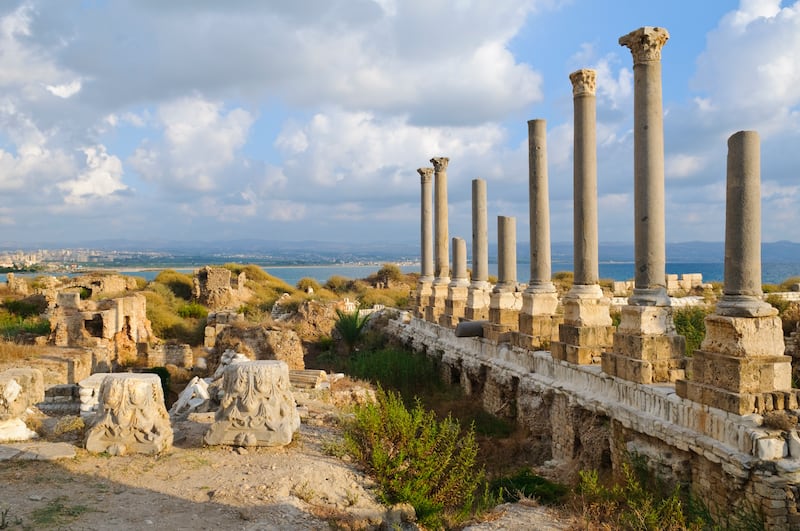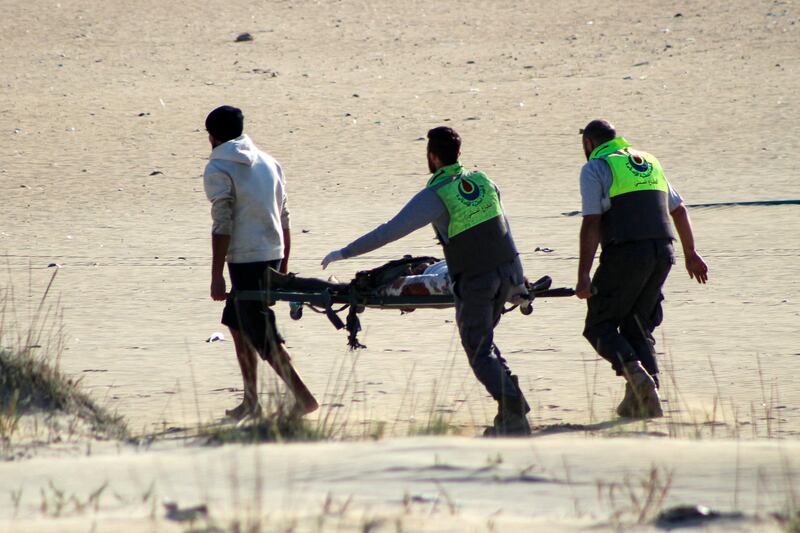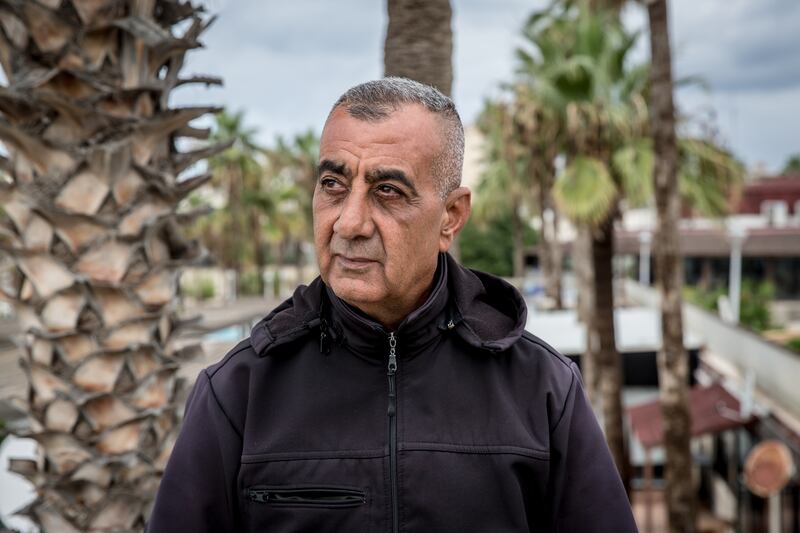A strong smell of burning hung in the air as the ancient city of Tyre came into view.
The approaching roads were markedly empty apart from a Lebanese army checkpoint and a few Unifil vehicles: the South Korean peacekeepers smiled and gave journalists a thumbs up. Stretches of road were littered with debris. An emergency vehicle rushed by, its sirens flashing. There had been a new air strike in the past hour, with more expected soon.
Tyre, known as Sour in Arabic, is about 25km from the Israeli border. The city was once a tourist destination, its beach considered one of the most beautiful and clean along this Mediterranean coast.
Now it is close to empty. In early October Israeli forces warned they were going to “operate in the maritime area against Hizbullah’s terrorist activities”, saying all people must “refrain from being in the sea or on the beach from now until further notice” as that would “pose a danger to your life”. Last weekend that threat was realised when two fishermen were killed by an Israeli drone on the sand.
READ MORE
Tyre is believed to be one of the oldest continuously inhabited cities in the world, recognised as a Unesco world heritage site since 1984. It was once “the most important centre for maritime and land commerce in the eastern Mediterranean”, Unesco says. It still contains Roman ruins, the remains of a Venetian cathedral and the walls of an ancient Crusader castle.

Israel’s launching of an intense aerial campaign across Lebanon prompted huge concern about historical sites, along with – more obviously – the massive civilian toll. At the end of October Unesco granted “enhanced protection”, including technical and financial assistance, to 34 Lebanese cultural properties, noting Israeli air strikes had already struck near world heritage sites in Tyre and in the eastern city of Baalbek.
Beirut Urban Lab, a research initiative, says that in less than a month from October 17th, 10 per cent of Tyre’s built environment, amounting to about 1,100 buildings, was subjected to Israeli evacuation threats. A Sunday Times analysis, published in early November, said there had been more than 500 more air strikes outside of evacuation zones in the broader district of Tyre.
When The Irish Times visited last week gutted vehicles and toppled buildings were dotted along the city’s roads, at least one of them still smoking. It was not possible to see much else after an official for the militant group Hizbullah, whose permission was required to move around the city, said it had become too dangerous. More air strikes were expected imminently, he said – underlining the difficulties international journalists face trying to cover the full consequences of the war.

Despite the danger some locals were shopping. Two vegetable and fruit shops had produce laid out in bowls and baskets – oranges, turnips, aubergines. But the city, a shell of its former self, has seen a mass exodus since Israel intensified its assault against Hizbullah, displacing more than 1.2 million people. A third of all displaced people in Lebanon originated from the wider Tyre district, according to the Sunday Times analysis.
Hassan Dbouk, the mayor of Tyre, was unable to meet in person because he was attending the funeral of “friends, victims fallen”. Through WhatsApp messages he said more than 7,000 people still lived in the city. “We believe it’s our home, our past and future. Our roots. We are very connected to our land.”
Attacks in both directions continued even as reports of a potential ceasefire deal grew louder. Last week an Israeli air strike targeted Tyre’s main water facility, with Lebanon’s state media reporting that two local officials were killed: residents were encouraged to ration water until repairs were completed. A Unicef report last month said at least 28 water facilities had already been damaged by Israeli attacks in Lebanon, cutting off access to safe water for more than 360,000 people. International lawyers and organisations say Israel’s attacks on civilian infrastructure could constitute war crimes.
Most of those killed in Tyre have been civilians, Dbouk said, with the toll including a tenth of all paramedics in the district. The Lebanese ministry of health says 222 healthcare workers are among the more than 3,768 people killed by Israel since October 2023. Since October 1st this year 519 people have been killed in Lebanon’s south governorate, including Tyre, according to the Lebanon crisis analytics team at humanitarian organisation Mercy Corps. On Monday alone 12 were killed in two locations in Tyre, Lebanon’s health ministry said.

Dbouk said a few hundred “warriors” – his term for Hizbullah fighters – were currently holding back an Israeli advance south of Tyre, “despite [Israel’s] air force and advanced western technology and weapons”. Dbouk was certain that even if they did make it further the Israelis could not maintain a presence in Tyre long-term: “they are destroying the city but certainly they can’t occupy the city.”
He said Israel paid a high price when it occupied Tyre in the 1980s, before “finally they ran away. [The] same will be repeated [this time] with a higher price”. A journalist based in Tyre now said they saw a burning Israeli tank in the far distance one day, showing how close the Israeli invasion had come.
A ceasefire deal is expected to require Israel to withdraw its troops from southern Lebanon, while Hizbullah would need to move heavy weaponry north of the Litani river. It will raise questions about how much of south Lebanon remains habitable, what can be rebuilt and who will pay for it. On Sunday EU foreign policy chief Josep Borrell said the Israeli army had “erased 37 entire villages”. Videos posted to social media showed Israeli forces carrying out controlled explosions, damaging or destroying at least nine religious sites, and flying an Israeli flag over at least one town.
At the back of a hotel beside Tyre’s beach last week Lebanese TV journalists maintained position, ready to go live, despite their fears that Israel could target them (many knew the three journalists killed 70km away in Hasbaya last month). They had a view along the coast, and could see smoke rising after air strikes or when Hizbullah launched rockets in the other direction. At one point they pointed out what they identified as white phosphorus, distinctive because of the trails it forms in the sky.
White phosphorus is a chemical substance that can stick to skin and ignites when exposed to oxygen. It can cause respiratory problems or deep burns, even leading to death. A mother from south Lebanon told The Irish Times her daughter had trouble breathing after accidentally playing with it following an Israeli attack.
A June report by Human Rights Watch called Israel’s use of white phosphorus in Lebanon’s south “widespread”, saying it had verified its use “in at least 17 municipalities across south Lebanon since October 2023, including five municipalities where airburst munitions were unlawfully used over populated residential areas”. The use of white phosphorus is generally prohibited in civilian areas, international lawyers say.
One of the journalists on duty in Tyre was Hussein Ezzddine, a 44-year-old from the area, who works for Iranian news channel al-Alam TV.

He said civilians remained in south Lebanon because “they have this way of thinking: ‘this is our land, we’re not leaving it whatever happens’. And some of these people don’t have a place to stay, so like, if they leave their houses, they’re gonna end up homeless on the streets. They prefer to die in dignity in their house”.
His words were punctured by two sonic booms, one of the methods Israel uses to frighten the Lebanese population. They are caused by Israeli jets flying fast at low altitudes, and sound similar to an explosion.
- Listen to our Inside Politics Podcast for the latest analysis and chat
- Sign up for push alerts and have the best news, analysis and comment delivered directly to your phone
- Find The Irish Times on WhatsApp and stay up to date















